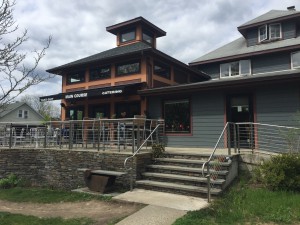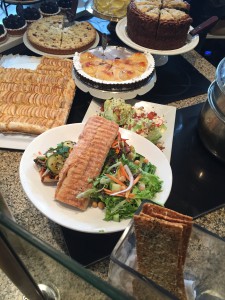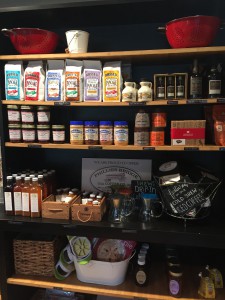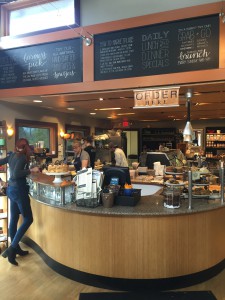For my independent exploration of Hudson Valley agriculture, I paid a visit to Wallkill View Farm in New Paltz. It is a family-owned and operated farm with an extensive permanent farm market on-site. They sell fresh produce and flowers grown on the farm, as well as products like jams, soaps, and gardening supplies and seeds. The wide range of offerings draws customers in an area abounding with apple farms.
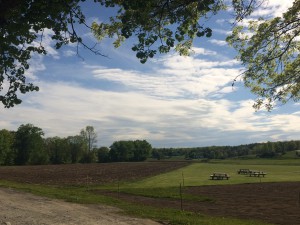
Located in the center of the roughly 200-acre property is the farm market, a group of buildings including the produce market, several large greenhouses full of flowers and vegetable plants for sale, and a bake shop. Standing in the parking lot, you get a view of the brick buildings of New Paltz to the east and of the distinctive formations of the Mohonk Preserve to the west. To the south, invisible to visitors, runs the farm’s namesake stream, the Wallkill.
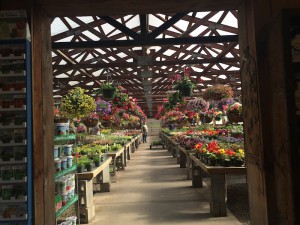
Three generations of the Ferrante family have farmed this land and sold their produce on-site. Founders Peter and Carol have been succeeded in the business by four sons and three grandchildren, although Tim, one of the sons, mentioned that his father still works there.
The open season at Wallkill View stretches from the end of March until Christmas Eve, and they offer varying produce and products during those times. According to their website (check out http://www.wallkillviewfarmmarket.com/), in spring they offer a wide range of annual and perennial flowers and herbs, as well as trees and shrubs. Summer is the right season for fresh fruit and vegetables, including seasonal favorites like sweet corn and berries. In fall they have a pick-your-own pumpkin patch and hayrides, and regional favorites like apple cider and cider doughnuts are available inside. To round out the open season, they sell Christmas trees in December–these they don’t grow on the farm.
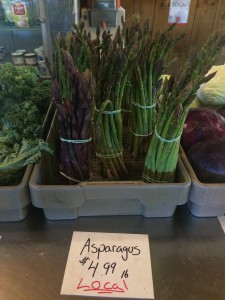
It is currently asparagus season–something of a controversial vegetable, in my experience; people either love or hate it. I asked Tim about vegetable popularity–surely there are some that just don’t sell as well as others? He agreed, of course there are hot-ticket items like corn and tomatoes, which sell very well. On the other hand, he said “You grow some stuff and you can’t give it away.” However, he explained that, as in any business, it’s a learning process to discover which crops work and which don’t with the customer base.
We also talked a bit about the family-farm dynamic. Tim remarked that the reason he stayed in the business was to be with his family, and he’s happy to see that the younger family members are keeping up with the tradition. When asked why he thought the average age of farmers in the US is fairly advanced, and what he thought the challenges facing young farmers were, he suggested, “The biggest problem of starting up is probably the cost–you know, the land, the equipment.” Small farms, though, are likely more manageable, as long as you market well, he remarked. Having a farm in the family is also helpful, since we saw many farmers this semester who have to search for and rent land; the young Ferrantes already have the land to farm, should they want to continue the practice.
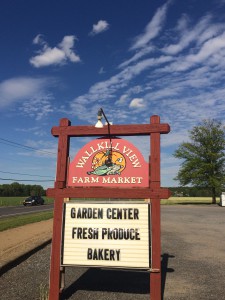 Wallkill View was an interesting contrast to the other farms we visited in class. As a family-owned and family-run business, it differs from some of the other farms whose farmers and owners were not one and the same. Wallkill View also seems a bit more commercial than some of the other farms, offering products and produce from other farms as well as their own. They also were, if my memory serves me, the only farm I saw that relies on its own store instead of taking its produce to market. Overall, it seems like a charming and accessible option for New Paltzers and travelers alike to buy produce and locally-made products.
Wallkill View was an interesting contrast to the other farms we visited in class. As a family-owned and family-run business, it differs from some of the other farms whose farmers and owners were not one and the same. Wallkill View also seems a bit more commercial than some of the other farms, offering products and produce from other farms as well as their own. They also were, if my memory serves me, the only farm I saw that relies on its own store instead of taking its produce to market. Overall, it seems like a charming and accessible option for New Paltzers and travelers alike to buy produce and locally-made products.
